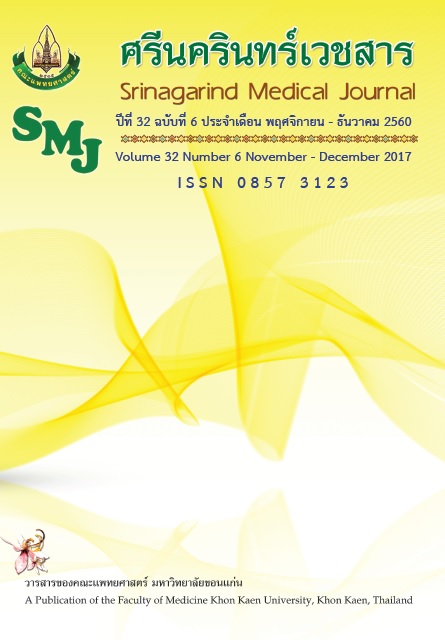The Prognostic Factors of Recurrent Peritonitis in CAPD Patients
Keywords:
Recurrent Peritonitis;, Prognostic FactorsAbstract
Background and Objective: Infection is significant complication of continuous ambulatory peritoneal dialysis (CAPD). Despite several studies had revealed the factors associated with CAPD infection but not regarded of infection interval time and re-infection.This study aimed to investigate factors associated with the infection of CAPD patients.
Methods : This study retrospectively collected CAPD patient’s data of Surin hospital from January 2009 to May 2015. Research data comprised of age, concomitant disease, date of CAPD initiation, infection duration, latest follow up date, blood concentration level, albumin level, white blood count and cumulative blood sugar level. Exclusion criteria are missing the latest follow up data and the patients that less than 15 year-old.
Results : There were 482 Continuous Ambulatory Peritoneal Dialysis (CAPD) patients during period of the study and 186 patients reported with infection complication (330 events). Patient had hypertension (63.69%), mean hematocrit 30.22 ± 6.16 %, mean serum albumin 3.29 ± 0.79 g/dl, mean time of interval time of infection was 141 days (30, 362) and 246.5 days (79, 574) days of non infection period. This study found that patient with blood concentration lower than 30% significantly increased risk of infection to 45% (95%CI 1.06-1.99), p =0.018 and also significant of risk for re-infection to 48% (95%CI 1.03-2.14), p =0.036 when interval time between infection and re-infection were considered and educational level was the positive factor for CAPD infection.
Conclusion : Study of factor associated CAPD infection with regarding of infection duration and individual factors found that lower blood concentration (<30%) increased risk of infection to 45% (p = 0.0418) and increase risk of re-infection 48% (p =0.036).
References
2. Sakacı T, Ahbap E, Koc Y, Basturk T, Ucar ZA, Sınangıl A, et al. Clinical outcomes and mortality in elderly peritoneal dialysis patients. Clinics 2015; 70: 363–8.
3. Okayama M, Inoue T, Nodaira Y, Kimura Y, Nobe K, Seto T, et al. Aging is an important risk factor for peritoneal dialysis-associated peritonitis. Adv Perit Dial Conf Perit Dial 2012; 28: 50–4.
4. The Factor associated with the risk of peritonitis among CAPD patients at Benjalakchalermprakret 80 Pansa Hospital,Srisaket Province [Internet].[Cited Aug 8, 2017]. Available from: 203.157.165.4/ssko_presents/file_presents/3330400537771-13-1621.doc
5. Bunnag S, Thanakitcharu P, Krairittichai U, Jirajan B, Meenune W, Kanjanapanth C. Risk factors of infectious peritonitis of CAPD patients in Rajavithi Hospital. J Med Assoc Thail Chotmaihet Thangphaet 2011; 94 (Suppl 4): S37-43.
6. Lobo JVD, Villar KR, Júnior A, De MP, Bastos K de A. Predictor factors of peritoneal dialysis-related peritonitis. J Bras Nefrol. 2010; 32(2): 156–64.
7. Han SH, Lee SC, Ahn SV, Lee JE, Kim DK, Lee TH, et al. Reduced residual renal function is a risk of peritonitis in continuous ambulatory peritoneal dialysis patients. Nephrol Dial Transplant Off Publ Eur Dial Transpl Assoc - Eur Ren Assoc 2007; 22(9): 2653–8.
8. วาสนา สวนพุฒ. ปัจจัยที่มีผลต่อการติดเชื้อในผู้ป่วยล้างไตทางช่องท้อง อำเภอสอง จังหวัดแพร่. วารสารวิชาการสาธารณสุข 2557; 23: 2: 284–9.
9. Geerlings SE, Hoepelman AI. Immune dysfunction in patients with diabetes mellitus (DM). FEMS Immunol Med Microbiol 1999; 26(3–4): 259–65.




